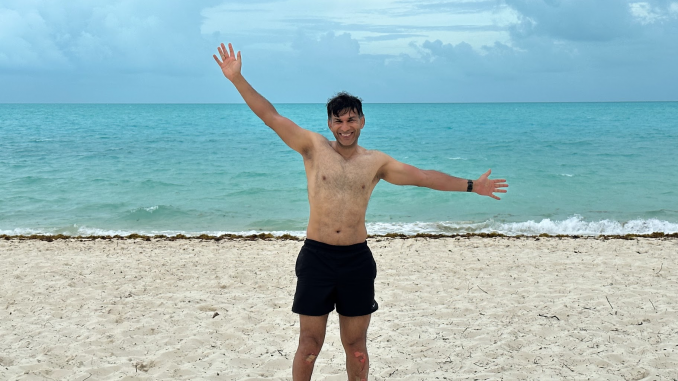
In this blog, I’ll describe my recent trip to Turks and Caicos islands. I wanted to get out of the concrete jungle of NYC and also take wingfoiling lessons, as learning wingfoiling is one of my goals for this year.
Wing foiling or wing surfing or winging is a wind-propelled water sport that combines elements of windsurfing and kitesurfing. The sailor, standing on a board, holds a wing. The wing generates both upward force and sideways propulsion and thus moves the board across the water. A foil is attached to the board through a mast. As the board moves through the water, the foil produces lift and at some point pushes the board up so it is no longer touching the water and is gliding (also called “flying”) through the air. Here’s how it looks like.
I have been kitesurfing for more than 10 years and see an increasing number of wingfoilers when I go kitesurfing. Foilers describe it as a highly addictive and exhilarating experience. Because the foil that provides the lift to keep the board (on which the sailor is standing) stays in the water and is not visible to an onlooker, it seems like magic to see the sailor flying through the air, propped up by some invisible force. It is also considered safer than kitesurfing, because the wing is a lot smaller than a kite and the sailor is just holding the wing instead of being hooked to it and thus can let go of the wing at will.
I took a wing lesson in Cancun, Mexico in December last year where I learnt to use a wing on a board without a foil attached to it. However there was very little wind and I didn’t learn much.
After considerable research on good places to take wingfoiling lessons, I settled upon Turks and Caicos. I had been to the islands a long time ago to celebrate the 30th birthday of one of my friends. We stayed at a Club Med and had a good time. I was just learning kitesurfing at the time and went out kitesurfing once in strong offshore winds, which could have been a disaster, but thankfully nothing bad happened.
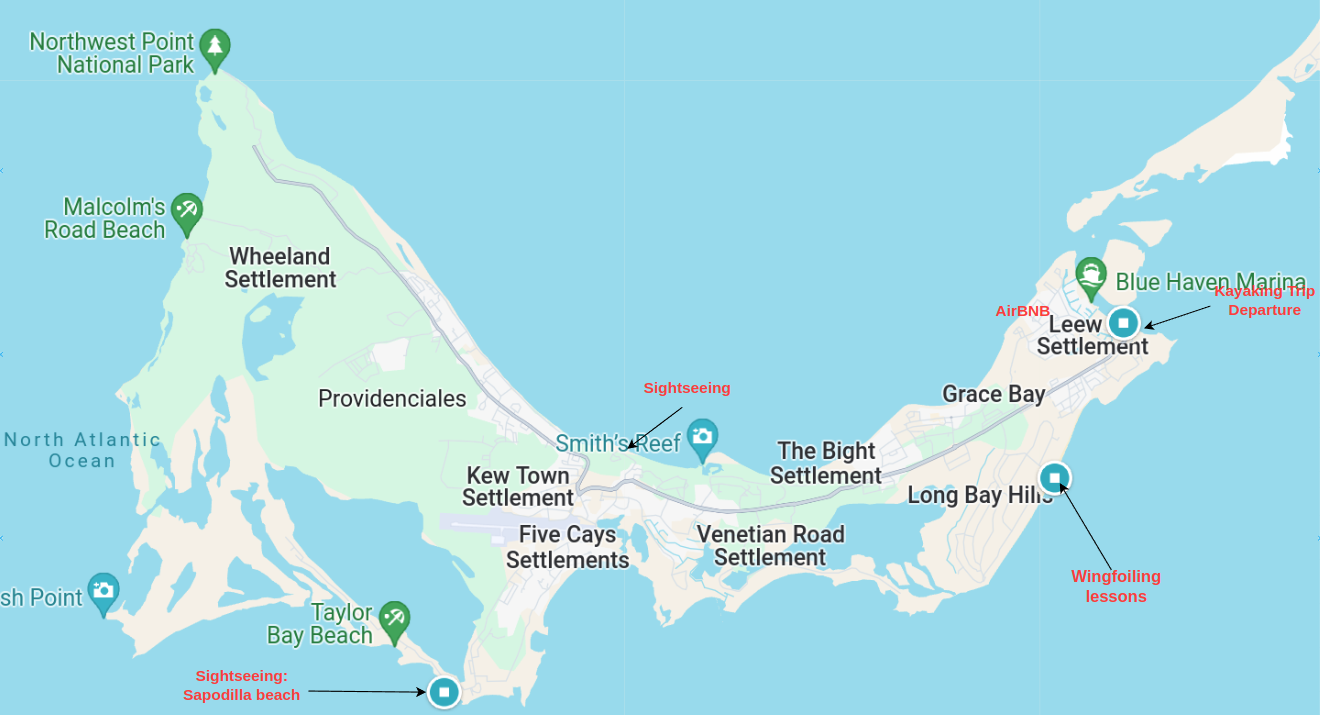
I contacted a couple of schools that give wingfoiling lessons. They said the wind is a bit light around this time of the year, but if I stayed 4-5 days, I should get at least 2-3 days with decent wind. So I booked a Jet Blue flight direct from JFK to Providenciales, the capital of Turks and Caicos from June 2-6. I considered staying at the Club Med again, but it is quite pricy at this time. Considering the expense of taking wingfoiling lessons and renting equipment, I decided to get an Abnb instead. There were several options within 5-6 Km of the wingfoiling schools, most of which are located on Long Bay (see map above). I negotiated the rates for a couple of promising options and got my opening bid in each case (which I should have set lower in hindsight!). I ended up paying about $640 for 5 nights, Abnb fees included.
I addition to wingfoiling and kitesurfing, I did some sightseeing at popular beaches such as Smith’s Reef and Sapodilla beach (see map above) and went kayaking to Mangrove kay.
General tips about traveling to Turks and Caicos
- The islands are British off-shore territories, but use the US Dollar. However people drive on left side of the road and the steering wheel is on the right side of the car, like in the UK
- There is no public transportation. You must rent a car to go around, unless you are staying in an all-inclusive resort like Club Med. Renting a car is cheap and easy, though petrol is expensive (~7$/gallon). However the island is small and most places you’d want to visit are close to each other. The roads are generally quite good
- Because everything is imported, food/drinks/items in the store are expensive.
- If you are into water sports, I recommend bringing snorkeling equipment, kitesurfing gear (you can easily pack multiple kites and board in a golf bag, which counts as one checked luggage). Renting gear can get expensive!
- There are several all-inclusive resorts, but they can get quite expensive. There are several Abnb options, which are more affordable. Try to negotiate the rates, all the hosts I communicated with were willing to lower the nightly rate
Trip details
My flight to Providenciales left JFK around 8 AM. Per usual, I didn’t get up in time, and arrived at JFK Terminal 5 about 50 min before the flight. The first person I spoke to at the check-in counter told me check-in was over and I missed my flight. But then to my great relief, a more experienced agent standing nearby worked some magic and was able to reopen the flight and issue me a boarding pass. My relief didn’t last long because the line for security was massive and moving very slowly. It was almost 8 by the time I got through security. I ran to the gate, only to see the plane pulling away from the gate. Fortunately, Jet Blue was able to get me a seat on the next flight that left at 11 AM. I got myself a breakfast and read some articles about how difficult it is to learn wingfoiling 🙂
I arrived in Providenciales without further incident, enjoying the lovely views of the islands surrounded by turquoise blue water as the plane was landing. It was raining heavily when I arrived. There was no jetway at our gate and we had to walk a short distance from the airplane to the gate. I got a bit wet entering the airport. It took some time to go through immigration because there weren’t many immigration officers and they were talking their time. I had booked a rental car since public transportation is nearly non-existent and taxis aren’t very common on the island. The rental company’s van drove me to the rental car office a short drive from the airport. I was able to get a small car after about 30 min, about as efficient as a typical car renting experience in the US.
Turks and Caicos is a British overseas territory and residents of the islands are full British citizens. As in Britain, people drive on the left side of the road and the steering is on the right side of the car. Most intersections and roundabouts, there are hardly any traffic lights. However the US Dollar is legal tender and people generally speak American-accented English. I can switch between left and right side driving quite easily and had no trouble adjusting to left side driving. I drove to my Abnb, about a 20 min drive from the airport. I had a room in a villa owned by a family of Indian origin (at least from the name). The room wasn’t great, but was adequate for my purpose.
Having only eaten breakfast, I dropped my luggage in the room and drove to a nearby shopping area to get some food. Because food (like most items on the islands) is imported, it is more expensive than I had expected. A decent lunch or dinner will easily cost $50 or more. Many places will automatically add a 10% service charge. There are several all-inclusive resorts on the island–some like Club Med are exclusive to guests only, others are open to non-guests. I found the restaurants in these resorts better quality than general restaurants not associated with a resort. One example is Pelican bay resort, where I had breakfast couple of times. The ambiance and service was nice, food and coffee ok’ish.
It was only about 5 PM by the time I finished lunch, and there was still about 3 hours of day light left. The rain had stopped and it seemed windy. I texted Onda watersports, one of the wingsurfing school on the island I had been in contact with. I asked if I could come by for a lesson. They weren’t set up for a lesson, but I decided to just rent the equipment and practice on my own. I had taken a wing lesson in Cancun in Dec last year and knew the basics of handling the wing. When I arrived on the beach, the wind was straight on-shore and the water a bit choppy. I had major issues standing up on the board and maintaining balance for more than a few seconds. After struggling for an hour or so, I came in and returned the equipment.
For dinner, I wanted to eat something healthy and preferably organic. A google search suggested The Farm, an upscale restaurant situated in an open-air garden on Seven Stars Resort & Spa’s grounds in Grace bay, a hip and popular area on the islands. So I drove to The Farm and the restaurant lived up to the reviews. I enjoyed an excellent Buddha bowl watching Djovokic take down Musseti in an exciting 5-setter in the 2024 French Open.
Day 2
The weather the next day was perfect for a wing foiling lesson. The wind was blowing 15-20 knots with cloudy skies. I decided to try the second wing-foiling school I had been in touch with and booked a morning lesson. It was a bit tricky to find them, but they sent good directions on Whatsapp with arrows pointing to the location by the beach where I could park my car. The instructor (named Jesus) quickly corrected how I was holding the wing and taught me how to flip the wing without too much effort, something I was struggling with the day before. The board we used in the lesson was ~150L, about 10L bigger than the board I used the day before. Bigger boards are easier to balance on, so I found it a bit easier to hoist myself on the board and get in a kneeling position and eventually stand up on the board. However as soon as I picked up some speed, I’d lose my balance and fall-off. With some pointers from Jesus and prior experience from kitesurfing and windsurfing, I began to make progress. I had to remind myself to not look at my feet but where I wanted to go, and to tuck my butt in and stand up straight. Those two things are key to staying in balance on the board, which can feel like standing on a ball as the board is being buffeted by the waves. I also practiced shifting my weight back and forth from front to the back foot and moving the wing towards and away from the body. You need to do those things to point the board upwind or downwind. After about an hour of practice, I was able to balance on the board, but as soon as I picked up some speed and the foil kicked in, I’d lose my balance and fall off. The almost straight on-shore wind wasn’t helping, as I constantly had to walk the board back upwind to where the water was deep enough that the foil wasn’t dragging on the bottom.
The whole experience reminded me of my early days learning kitesurfing when I spent most of the time walking the kite upwind. No matter what anyone says, learning wingfoiling is hard!
After about 2 hours, I was beat. I dragged the board back to where the lesson started and sat down to drink some water and get some rest. That’s when I noticed my knees. I had been grazing my knees against the board while scrambling up on the board and getting in a kneeling position and that had scrapped the skin off in many areas! Caught in the excitement of learning a new activity, I didn’t even feel the pain!
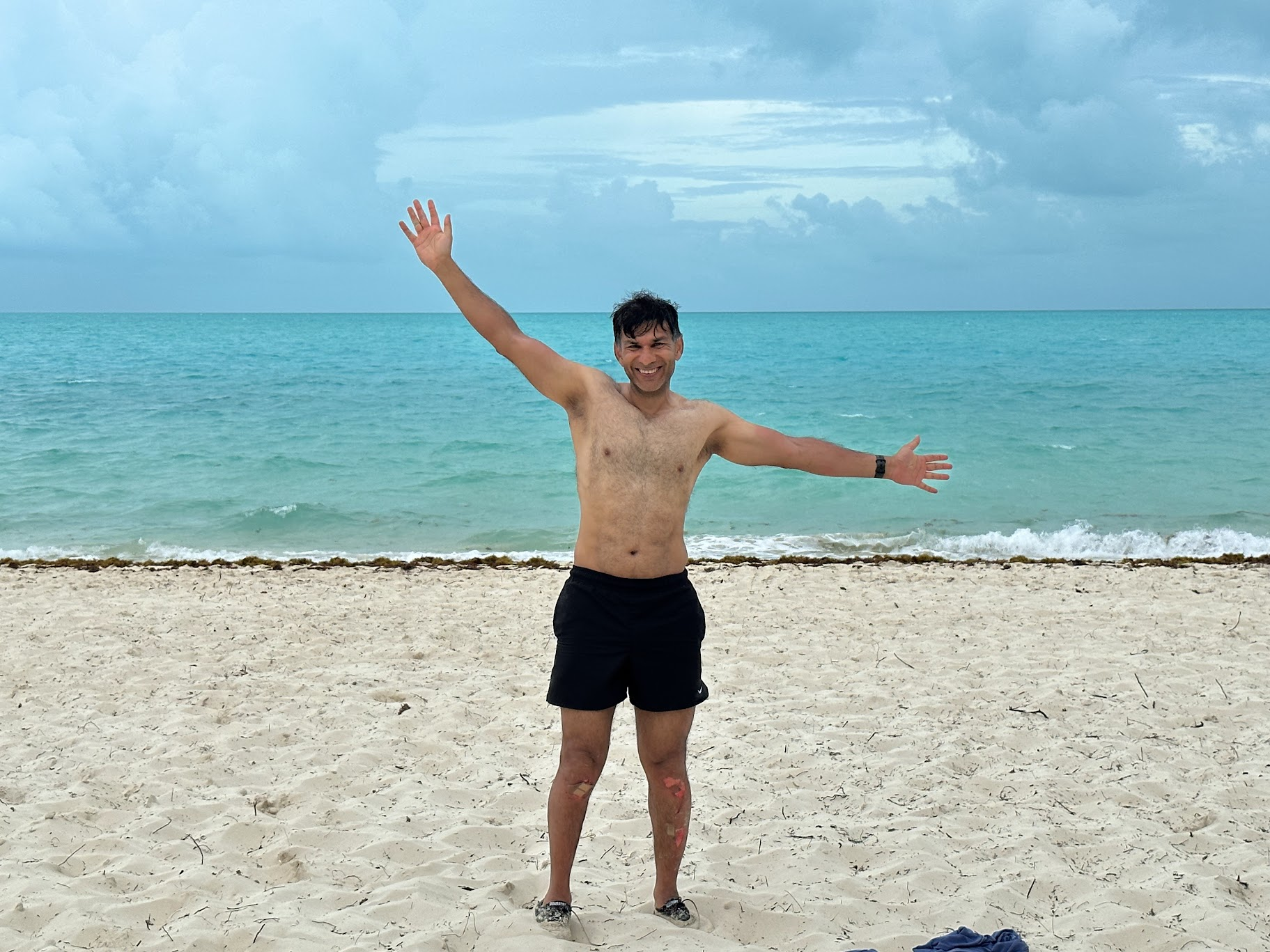
The instructor was surprised to see the scrapes and had never seen something as bad as that. I was equally surprised, because I have never had scrapes like this before. Perhaps I have delicate skin? Anyhow, the scrapes had to be dressed so I searched for a pharmacy. Most of the nearby ones were closed, it being a Sunday. One near Providenciales, about a 20 min drive was open until 4. I arrived at the pharmacy around 2, but the attendant said they are closing early that day. Upon showing him my scrapes, the attendant took pity on me and let me in. I picked up some large band aids, wrap bandages, Tylenol and antiseptic cream. However the pharmacy for cash only, and I didn’t have any cash on me. Fortunately, there was an ATM a short walk away. The kind attendant agreed to wait while I scurried over to the ATM to get some cash. There was a line at the ATM and some of the machines weren’t working, but I was able to withdraw enough to last me the trip. I paid for the medical supplies and thanked the attendant for waiting for me. I applied the antiseptic cream and band aid on the scrape and wrapped the bandage around the knee. At this point, I was quite hungry and miserable. I drove back to Grace bay area and had lunch at Coco Van, a nice outdoor restaurant that the instructor had recommended. My spirits lifted by the food and coffee, I drove back to the wing-foiling school. There, I met Jenna and Barbara, friends of the instructors and frequent visitors to Turks and Caicos. Jenna and Barbara are both nurses and re-wrapped the bandage so it fit better over the knee. Ever persistent and not to be defeated easily, I decided to go out again. I borrowed the instructor’s wet suit pants and knee pad (he only had one), pulled the pants over the bandage and wore the knee pad on the more severely injured knee.
The wet suit pants and knee pad helped a great deal. I felt a tinge when the knees made contact with the board, but nothing too painful. I made more progress during the second session. Practiced standing up more quickly from the kneeling position, powering the wing by moving my hands down the handles, pointing the board upwind by applying pressure on the backfoot etc. Couple of times I even got on the foil, but only briefly. As soon as the foil lifts the board out of water, it picks up speed and the wing gains power (because the lift produced is proportional to the square of the relative velocity between the wing and the wind). I needed to work on depowering the wing as the board picked up speed, but wasn’t staying on the board long enough to practice the right instincts.. the short headroom on the beach wasn’t helping either, because I could only go downwind a short distance before the foil hit the bottom.
After about an hour of practicing, I was getting tired and decided to call it a day with wingfoiling. The wind was blowing 15-20 knots and it was a beautiful day so I decided to rent out a kite and do something I already knew how to do well. I had a great time kitesurfing for a couple of hours, riding the waves on the way in, doing short jumps, riding toe-side etc. I came back in after the wind started dropping and it became difficult to stay upwind.
Totally beat for the day, we decided to rest a bit and meet at The Farm for dinner. There was a singer singing pop and light rock classics from the 70s and 80s so well that for a couple of songs I forgot I was listening to live music! He sounded just like the original singer. The food was again excellent. The soup of the day was a delicious lentil soup, which reminded me of my mother’s cooking.. the best culinary compliment in my book. We had a great time exchanging kitesurfing war stories, and getting to know each other.
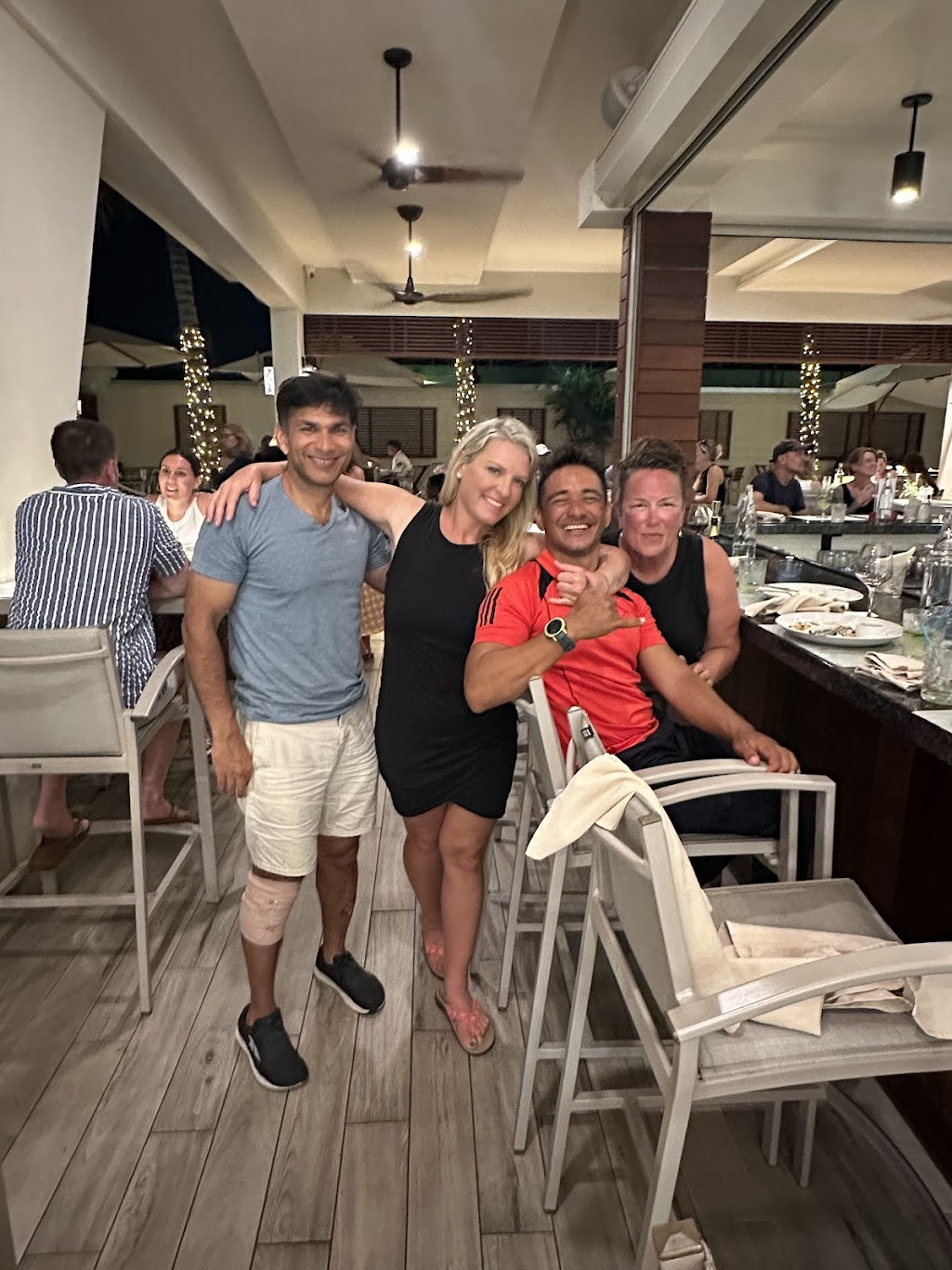
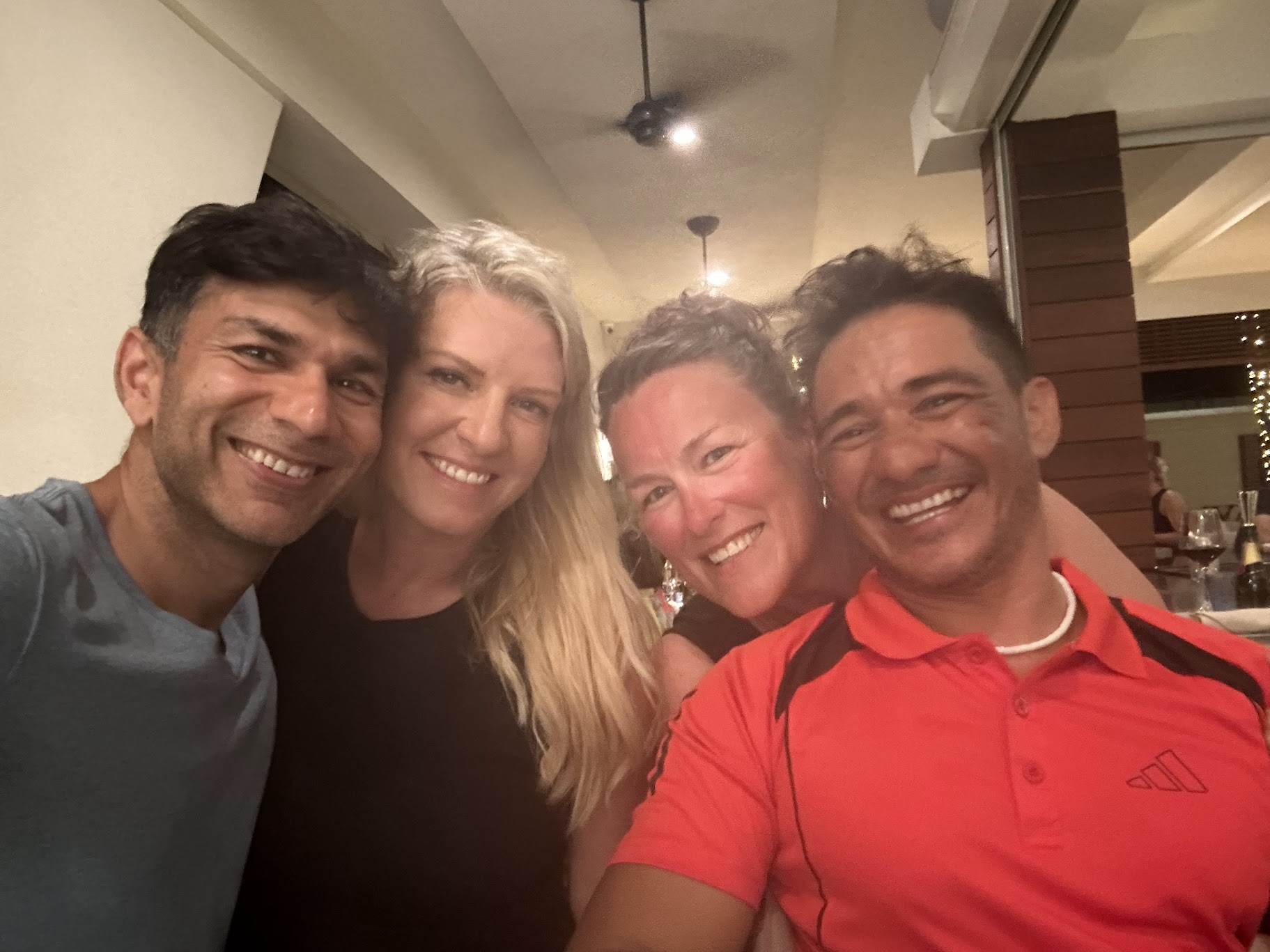
After dinner, we decided to go a “bit crazy” and went dancing at the nearby club Med, an exclusive, guest-only resort. We parked our cars at a parking lot by the public beach next to club Med and just walked in as if we were staying there. However, club Med’s intruder detection patrol was on our scent right away (probably because we weren’t wearing the wrist bands that club Med guests wear) and nicely escorted us to the reception, where we were given the option of staying by paying $100 each or be escorted out of the club. Jenna did a wonderful job playing the dumb blonde who didn’t know what she was doing and just wanted to dance, but to no avail. 100$ per person seemed a bit excessive, so we all left, discreetly escorted by intruder patrol guards who’d gently redirect us if we strayed from the path we were supposed to follow. So we didn’t get to enjoy club Med’s hospitality, but we had a fun experience anyway :-).
Day 3
The next day was again super nice with 15-20 knots of wind and cloudy skies. However my back and knees were starting to hurt a bit from the beating the day before. So I started the day with kitesurfing. Had an amazing time going back and forth, jumps, riding the swells etc. I kited upwind about a quarter mile from the beach where the water is ankle deep and sand pure white.. it was breathtakingly beautiful. Two small downsides–the water is ocean water, so if you wipe out, you may swallow some salty water and the wind was almost straight onshore, so you have to work a bit kiting upwind.
I do need to learn some new kitesurfing tricks though. I have been doing the same few things for many years. I had started working on back rolls several years ago, but then chickened out.. After the session, Adrian gave me some tips on how to get started with back rolls.
After lunch, I gave wingfoiling another go. However my knees were starting to hurt a bit at this point, so this session wasn’t that great. Adrian gave me a very helpful tip on how to power the wing by moving my hands down the handle bars, which helped a lot to gain speed and start getting on foil, but I kept losing my balance as soon as the board rose out of the water.
I hung out with Jenna and Jesus, another kitesurfing instructor for a bit. Unlike Adrian who is really skilled at pulling kitesurfing tricks such as back rolls and front rolls at will, Jesus is a long distance kitesurfer. He showed us maps of how he almost kited around the Turks and Caicos islands all by himself on a directional board! That’s ~100 Km a day! He did some long distance kiting in Columbia as well, another place I want to visit.
The weather turned later in the evening and it started raining quite heavily. I had dinner at The Farms yet again. No lentil soup this time unfortunately!
Day 4
Tue June 4 was the last full day of my stay in Turks. It was a low wind day so I drove around and visited some of the well-known sightseeing spots on the islands. I also booked a kayaking tour in the evening
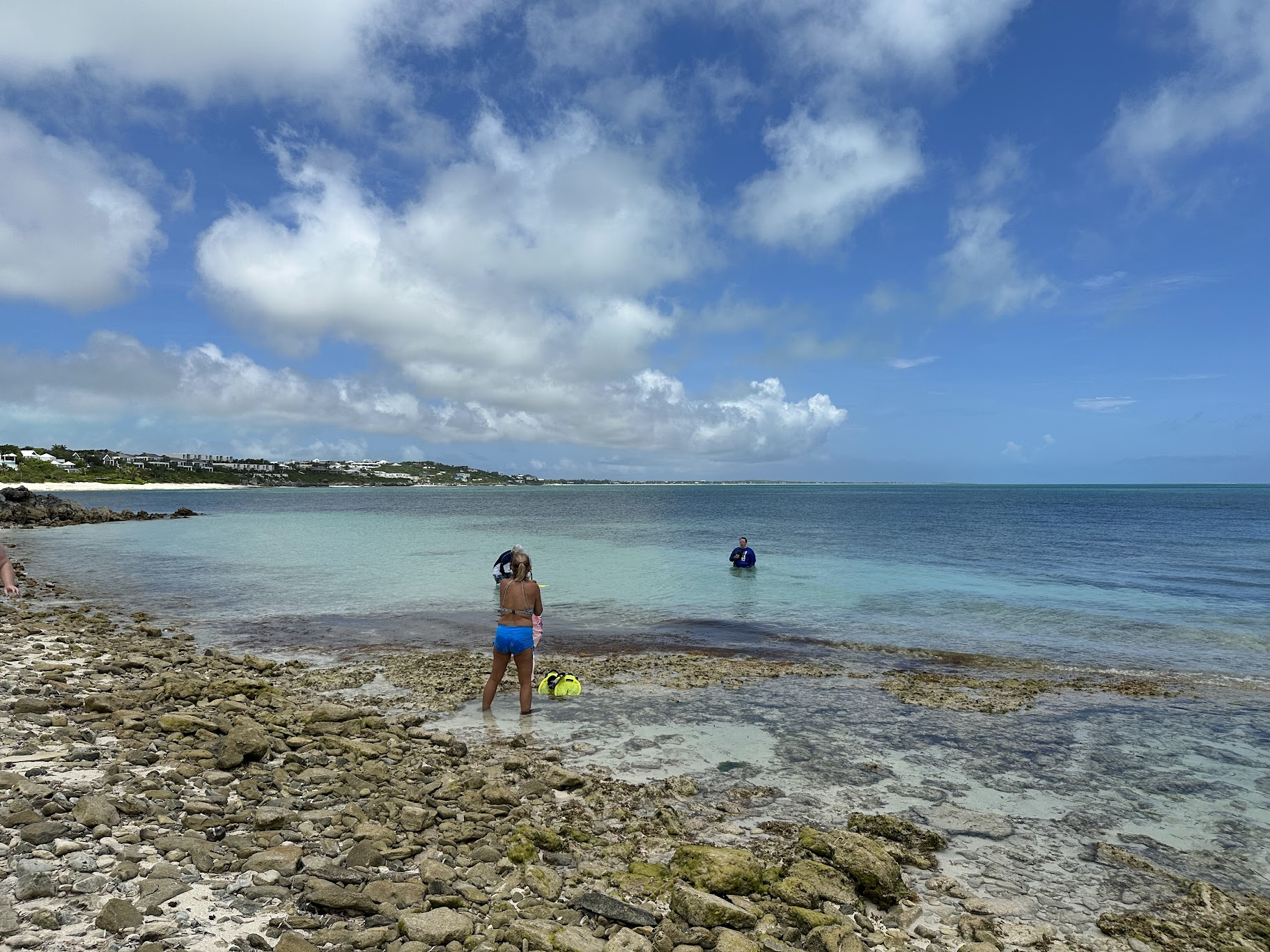
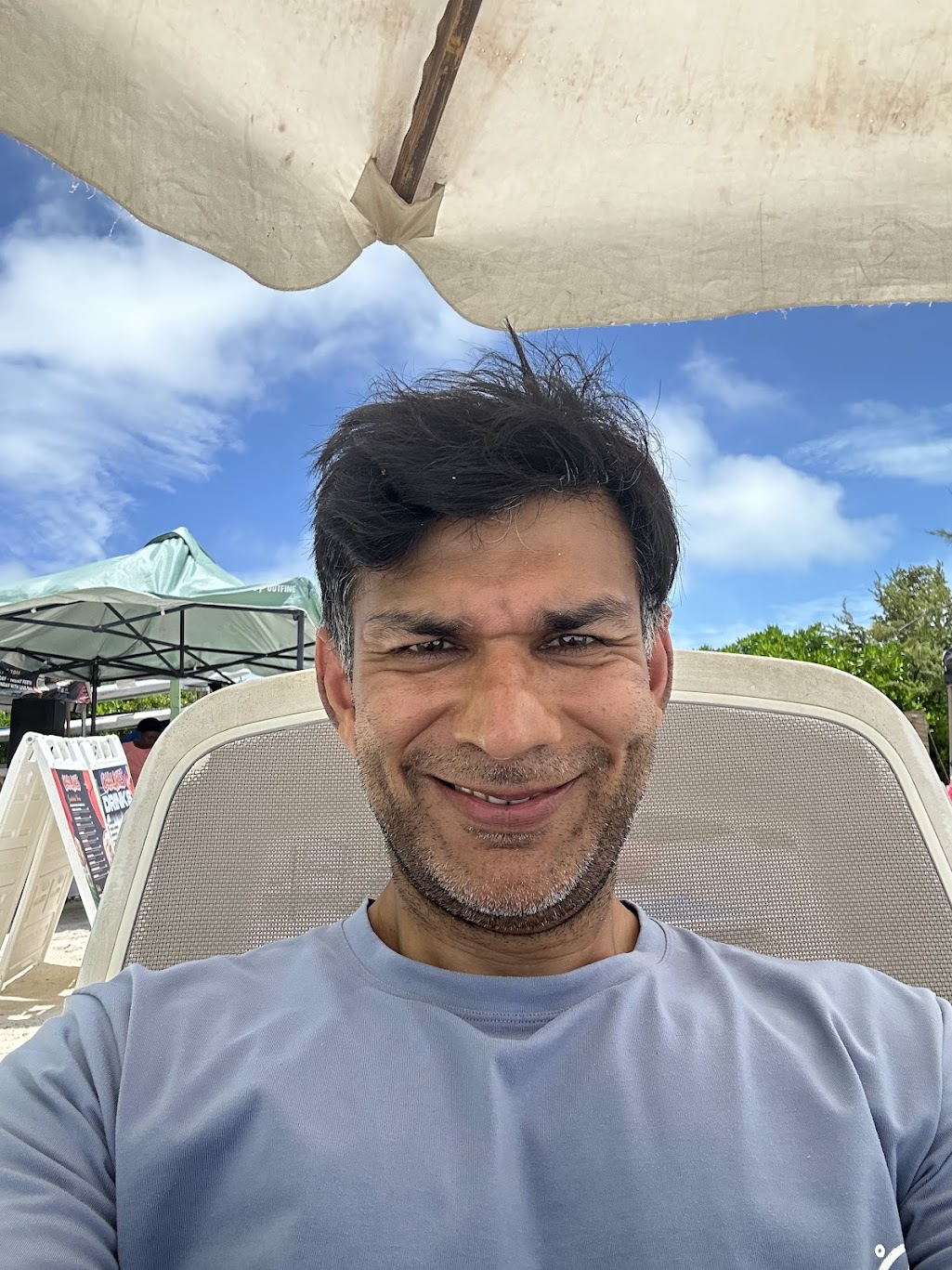
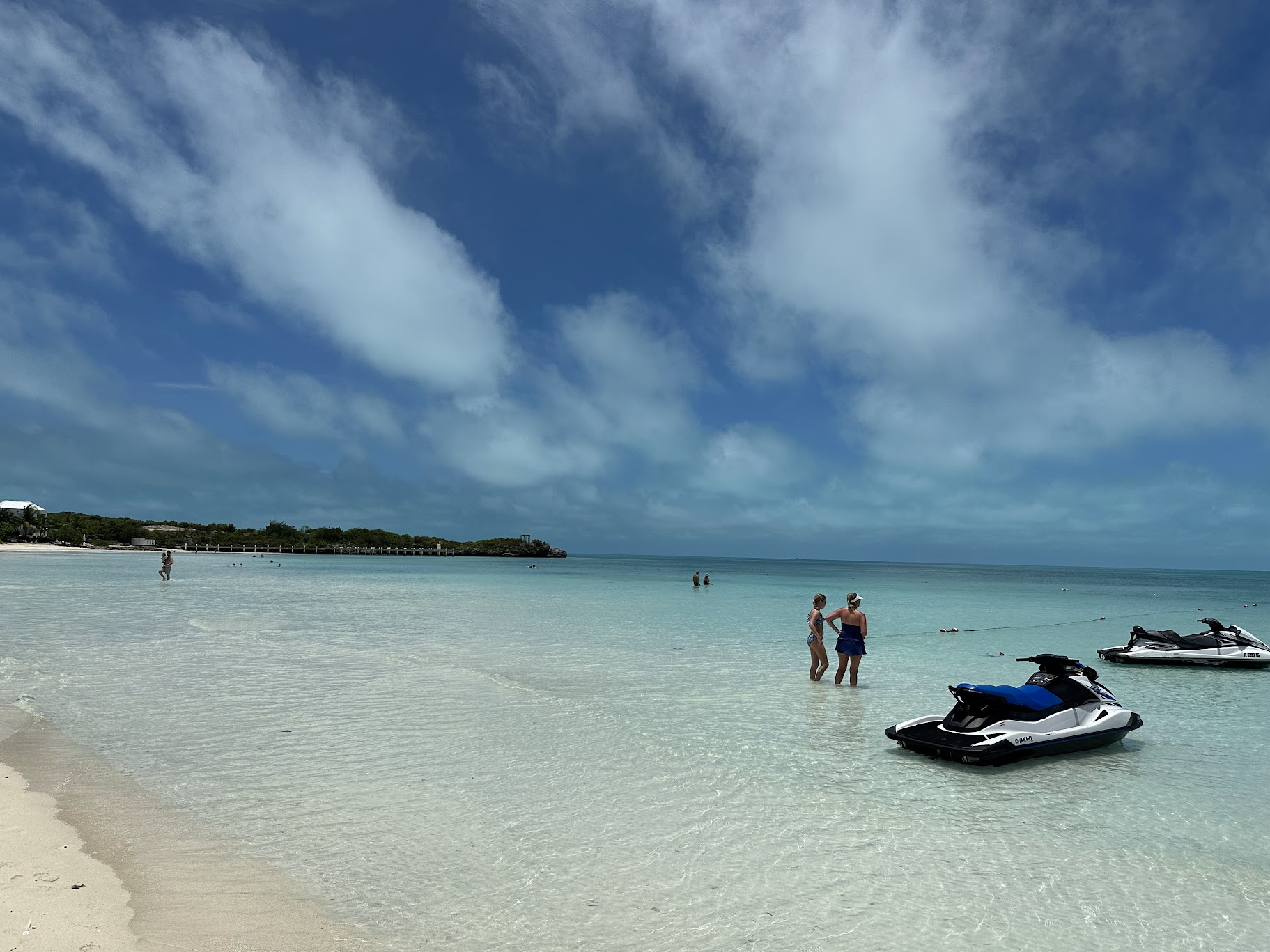
As I drove around, I was disappointed to note that most of the beachfront area is built over by lavish villas, compounds and resorts. Public access to the beach is through a narrow alley between two villas with no proper rules for parking. The revenue from sales and property tax from the villas is likely a big part of the island’s tax base, and this is why they encourage this type of property development, but they should still do more to ensure public beaches are easily accessible.
The kayaking tour left around 6PM in the evening from near the north end of Leeward settlement (see map above), quite close to my Abnb. Our kayaking area, a mangrove cay (“cay” is a low bank or reef of coral, rock, or sand), is located about half mile from the dock. To get to it quicker, we got in our kayaks (made out of clear plastic) and formed a kayak train with the kayaks connected by a rope. A motor boat towed the kayak train to the mangrove cay. We kayaked through inlets surrounded by mangrove plants and saw several baby sharks, sea turtles and a conch. The tide was going out, so there was a bit of current, even though we were technically in ocean water. The water was azure blue, perfectly warm. It was quite heavenly!

We saw a couple of baby sharks and lots of cute sea turtles!
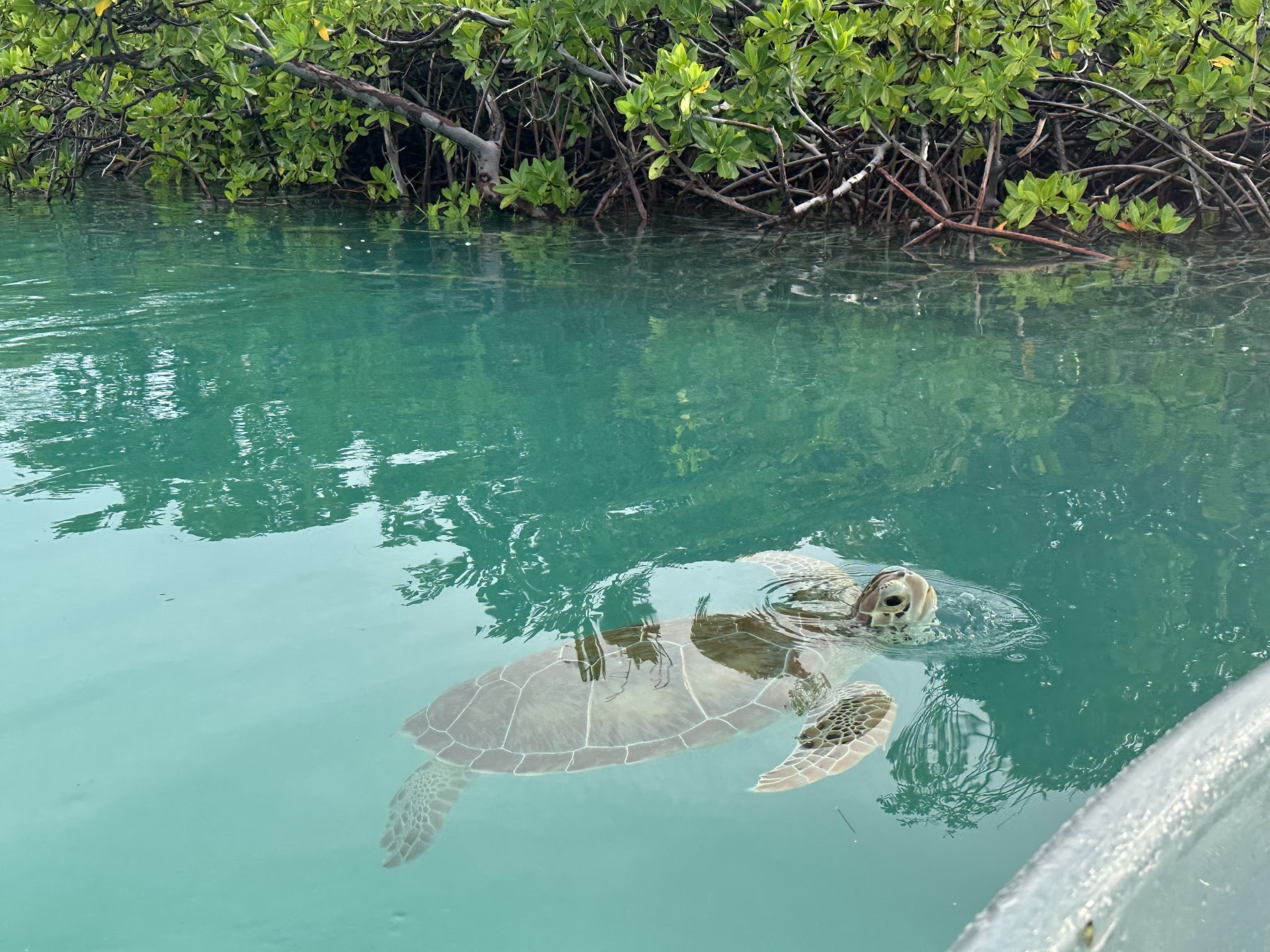
I had seen plenty of conch shells (in India they are used as a musical instrument during religious ceremonies. A holy man presses his lips on one end of the conch and blows air through it to create a high pitch sound that is supposed to scare away evil spirits) but had never seen the creator snail wiggling out of one! It is such a wonder of nature!
According to wikipedia, the sanskrit word for conch “sankha” is cognate (derive from a common origin) with conch, which comes from Latin concha (shellfish, mussel), which in turn comes from Greek konchē (same meaning). How interesting! And also a bit surprising, because the people who spoke the Proto Indo European language from which all Indo-European languages derive from, lived in today’s central Asia, which is totally landlocked, far away from the ocean.. but perhaps conch were found in the Black or Caspian seas which is in the area the ancestors of the Indo-Europeans originated from.
How does such a soft animal produce such a hard shell? According to Google AI, Conch snails create their shells using a tissue layer called the mantle. The mantle is located under and in contact with the shell, and specialized cells in the mantle secrete proteins and minerals to form the shell. The proteins act like steel, while the minerals act like concrete, and the shell grows from the bottom up or by adding material at the edges. The primary compound in mollusk shells is calcium carbonate, which binds to the proteins to form the shell.
Couple of fun facts about green turtles.
At around 80 years, they are one of the longest lived reptiles. They have an incredible life cycle. Sea turtle eggs are laid close to the beach. After incubating for approximately 60 days, a hatchling will crawl out of its nest and run down the slope of the beach towards the ocean — using the moon’s reflection on the water to help guide it. Eggs in the same nest all hatch within days of each other, and the baby turtles all move together towards the water. This increases their odds of making it past hungry mammals and birds of prey.
A hatchling heads out to sea, where it will live for 5-7 years among free-floating mats of macro algae like Sargassum, which it eats to grow and gain weight . As a juvenile, the turtle will make its next move — riding the currents across the open ocean to new homes in nearshore habitats where it will forage. Upon reaching sexual maturity, the female turtle mates and makes her way to the beach where she was born. Under the cover of darkness, the mother climbs up the beach and digs a nest in which she’ll lay 100 eggs or more. She then buries them under a sandy blanket and returns to the sea. A female green turtle may nest and lay eggs several times in a single season, but then won’t return to nest again for another 3-7 years.
How exactly does the turtle know which beach to return to? It’s still something of a mystery, although scientists believe genetic markers and Earth’s magnetic field both play a role.
Interestingly, jellyfish are a significant part of turtle’s diet. They have developed adaptations to eat jellyfish safely, despite their stinging tentacles and toxic properties. A green turtle can drink seawater, thanks to a pair of glands near its eyes that remove excess saltIsn’t that amazing. If you are interested in learning more about how animals sense the world, including senses such as electric and magnetic fields, which we lack, I highly recommend this amazing book:

After the kayaking tour, I had dinner at The Farm yet again.
Back to NYC..
My flight was scheduled to depart around 11 AM on Wednesday. A massive thunderstorm rolled in and it rained heavily all morning. There were no issues returning the rental car (slightly more paperwork involved than renting a car in the US, but otherwise a similar process) and I made it to the airport well in time. Jenna had borrowed Sapiens (an excellent book about human evolution by Yuval Hariri I had brought along) but we couldn’t meet the previous day to hand-off the book. She was catching an earlier flight also on Wednesday. We explored various options of doing an “asynchronous book exchange”, where she’d hide the book somewhere and I’d pick it up later. She ultimately found a place near the Jet Blue luggage sizer and sent me a picture. I was skeptical the book would still be there by the time I arrived at the airport, but my skepticism was misplaced! We both got such a kick out of pulling off this spy-like book exchange!
The departure area at the Providenciales airport is quite cramped and was full of passengers. There aren’t many good options for food/drinks. My flight was delayed by about an hour because of the storm, and the lights went out a couple of times causing some jitters, but ultimately I boarded the plane and return back to NYC without incident. I’ll be back for sure!
Hope you enjoyed reading this post! Leave a comment if you did. I love hearing from other travelers..

Great article!